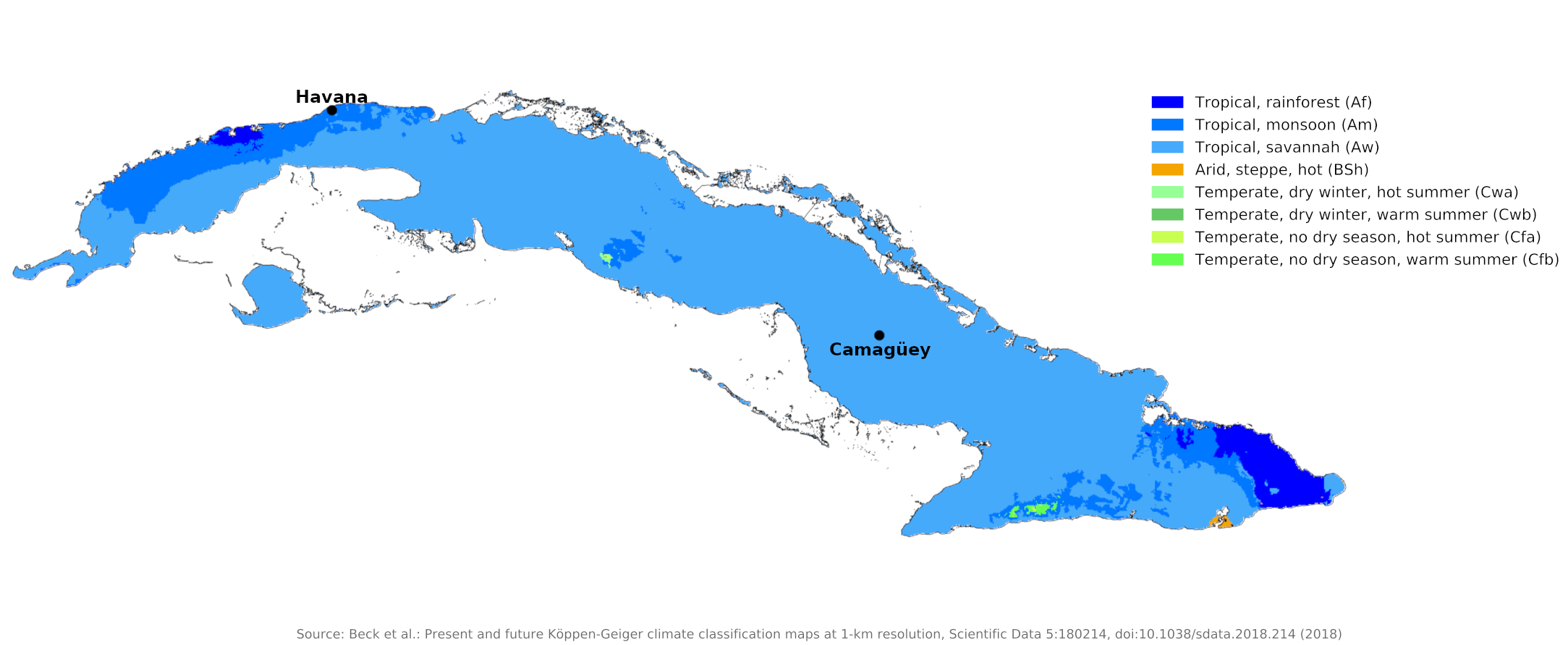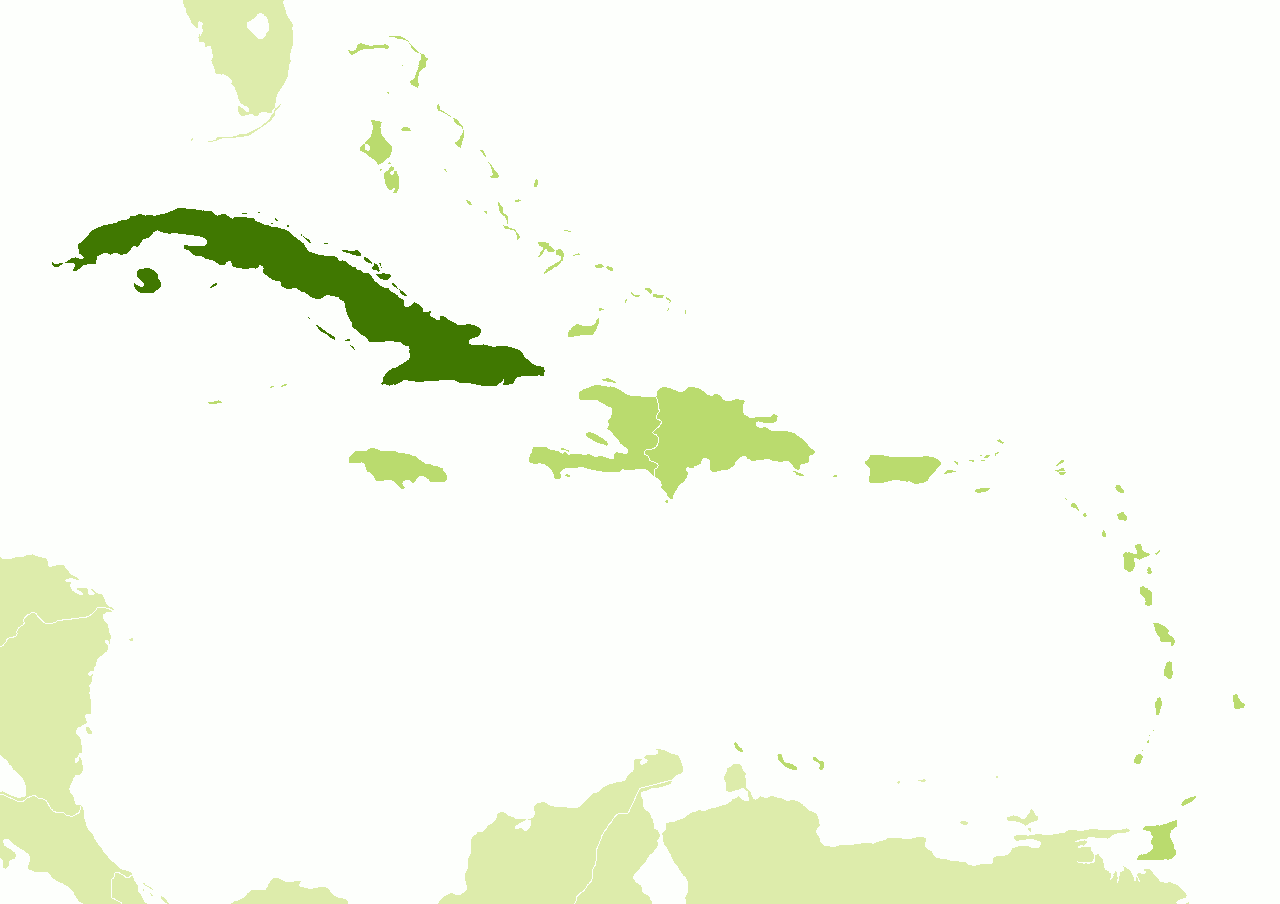The Climate of
Cuba
 Castillo de la Real Fuerza de La Habana
Castillo de la Real Fuerza de La Habana
Climate Map
 Climate map of the Cuba
Climate map of the Cuba
What is the climate of Cuba like?
Cuba is the largest of the islands of the Caribbean. It situated on the northern rim of the Caribbean Sea, about 160 km (100 mi) south of Florida. It is about as large as the state of Pennsylvania and a little smaller than England. It extends for a distance of almost 110 km (700 mi). Although there are mountains rising to 900 to 1,800 meters (3,000–6,000 feet), much of the island is low-lying.
Cuba has a pleasant subtropical climate strongly influenced by gentle northeast trade winds, which shift slightly to the east in the summer. The island's long, tapered shape allows the moderating sea breezes to cool all regions, and there are no pronounced seasonal variations in temperature. January, the coldest month, has an average temperature of 22°C (72°F), and August, the warmest month, has an average temperature of (82°F). During the dry season, temperatures moderate somewhat, especially in the west, as alternate cold and warm fronts dominated by the arrival of dry Arctic masses descend on Cuba and collide with warm southern winds. The average relative humidity is 81 percent.
On average, Cuba receives about 1,400 millimeters (55 inches) of rainfall a year, although the amount of rainfall from year to year can vary greatly. Two well-established dry and rainy seasons characterize Cuba's climate: a "dry" season from November to April, and a hotter, "wet" season between May and October. About two-thirds of the total rain falls in the latter.
The heat throughout the day is masked and relieved by the afternoon sea breezes. The trade winds are steady through the year, and in the dry season the western part of the island enjoys cool north winds. Despite this the interior is somewhat cooler than the coast, and in the highlands frost is not uncommon. The southern coast is also (except in sheltered points such as Santiago, which is one of the hotter cities of the island) somewhat cooler than the northern. Western Cuba is occasionally affected in winter and spring by waves of cold air from the interior of North America which cause temperatures to drop below 10°C (50°F) for a day or two. Such low temperatures are most unusual for the Caribbean Islands.
Havana and Camagüey are representative of the low-lying parts of the island. The mean rainfall at Havana is about 1,200 millimeters (45 inches), but can be twice that. The driest region of the island is in the southeast around Guantánamo, where rain can be as low as 500 millimeters (20 inches) a year. Northeastern Cuba receives the most rainfall with an annual average of 3,000 millimeters (120 inches). On average, rain falls on Cuba 85 to 100 days per year with three-quarters of it falling during the wet season. The humidity varies between 75 percent and 95 percent year-round.
Annual and seasonal variations in rainfall amount are influenced by the frequency and severity of hurricanes. Because of its tropical location, Cuba is hit periodically by different kinds of storms, especially hurricanes. Hurricane season lasts from July to November. September and October are the months of the most frequent storms. The country averages about one hurricane every year. Droughts are also common.
| Climate data for Havana (1961–1990) | |||||||||||||
|---|---|---|---|---|---|---|---|---|---|---|---|---|---|
| Month | Jan | Feb | Mar | Apr | May | Jun | Jul | Aug | Sep | Oct | Nov | Dec | Year |
| Average high °C (°F) | 25.8 (78.4) | 26.1 (79.0) | 27.6 (81.7) | 28.6 (83.5) | 29.8 (85.6) | 30.5 (86.9) | 31.3 (88.3) | 31.6 (88.9) | 31.0 (87.8) | 29.2 (84.6) | 27.7 (81.9) | 26.5 (79.7) | 28.8 (83.8) |
| Daily mean °C (°F) | 22.2 (72.0) | 22.4 (72.3) | 23.7 (74.7) | 24.8 (76.6) | 26.1 (79.0) | 27.0 (80.6) | 27.6 (81.7) | 27.9 (82.2) | 27.4 (81.3) | 26.1 (79.0) | 24.5 (76.1) | 23.0 (73.4) | 25.2 (77.4) |
| Average low °C (°F) | 18.6 (65.5) | 18.6 (65.5) | 19.7 (67.5) | 20.9 (69.6) | 22.4 (72.3) | 23.4 (74.1) | 23.8 (74.8) | 24.1 (75.4) | 23.8 (74.8) | 23.0 (73.4) | 21.3 (70.3) | 19.5 (67.1) | 21.6 (70.9) |
| Average precipitation mm (inches) | 64.4 (2.54) | 68.6 (2.70) | 46.2 (1.82) | 53.7 (2.11) | 98.0 (3.86) | 182.3 (7.18) | 105.6 (4.16) | 99.6 (3.92) | 144.4 (5.69) | 180.5 (7.11) | 88.3 (3.48) | 57.6 (2.27) | 1,189.2 (46.84) |
| Source: World Meteorological Organization | |||||||||||||
| Climate data for Camagüey | |||||||||||||
|---|---|---|---|---|---|---|---|---|---|---|---|---|---|
| Month | Jan | Feb | Mar | Apr | May | Jun | Jul | Aug | Sep | Oct | Nov | Dec | Year |
| Average high °C (°F) | 27.2 (81.0) | 28.3 (82.9) | 30.0 (86.0) | 31.7 (89.1) | 31.7 (89.1) | 31.7 (89.1) | 32.8 (91.0) | 32.8 (91.0) | 32.2 (90.0) | 30.6 (87.1) | 28.9 (84.0) | 27.8 (82.0) | 30.5 (86.9) |
| Daily mean °C (°F) | 22.2 (72.0) | 23.1 (73.6) | 24.5 (76.1) | 25.8 (78.4) | 26.4 (79.5) | 26.7 (80.1) | 27.5 (81.5) | 27.5 (81.5) | 27.0 (80.6) | 25.8 (78.4) | 24.2 (75.6) | 22.8 (73.0) | 25.3 (77.5) |
| Average low °C (°F) | 17.2 (63.0) | 17.8 (64.0) | 18.9 (66.0) | 20.0 (68.0) | 21.1 (70.0) | 21.7 (71.1) | 22.2 (72.0) | 22.2 (72.0) | 21.7 (71.1) | 21.1 (70.0) | 19.4 (66.9) | 17.8 (64.0) | 20.1 (68.2) |
| Average precipitation mm (inches) | 38.1 (1.50) | 35.6 (1.40) | 61.0 (2.40) | 91.4 (3.60) | 193.0 (7.60) | 266.7 (10.50) | 142.2 (5.60) | 139.7 (5.50) | 185.4 (7.30) | 137.2 (5.40) | 78.7 (3.10) | 50.8 (2.00) | 1,419.8 (55.90) |
| Source: Sistema de Clasificación Bioclimática Mundial | |||||||||||||
References
- E. A. Pearce, Charles Gordon Smith, (1990) The Hutchinson World Weather Guide, John Murray Press. ISBN 1859863426
- Timothy L. Gall, (ed.), (2003), Worldmark Encyclopedia of the Nations, Eleventh Edition, Thomson Gale
- Federal Research Division, Library of Congress, (2002), Cuba: a country study. Claitor's Pub. Division.
- Hugh Chisholm, (ed.), (1911), Encyclopædia Britannica, Eleventh edition, Cambridge University Press
The Climate of
Cuba

In summary:
Except in the mountains, the climate of Cuba is tropical. The average minimum temperature is 21°C (70°F), the average maximum 28°C (82°F). The mean temperature at Havana is about 25°C (77°F). The trade winds and sea breezes make coastal areas more habitable than temperature alone would indicate.
Cuba has a rainy season from May to October. The mountain areas have an average precipitation of more than 1800 mm (70 in); most of the lowland area has from 900 to 1400 mm (35 to 55 in) annually; and the area around Guantánamo Bay has less than 650 mm (26 in). Droughts are common. Cuba's eastern coast is occasionaly hit by hurricanes from August to October.